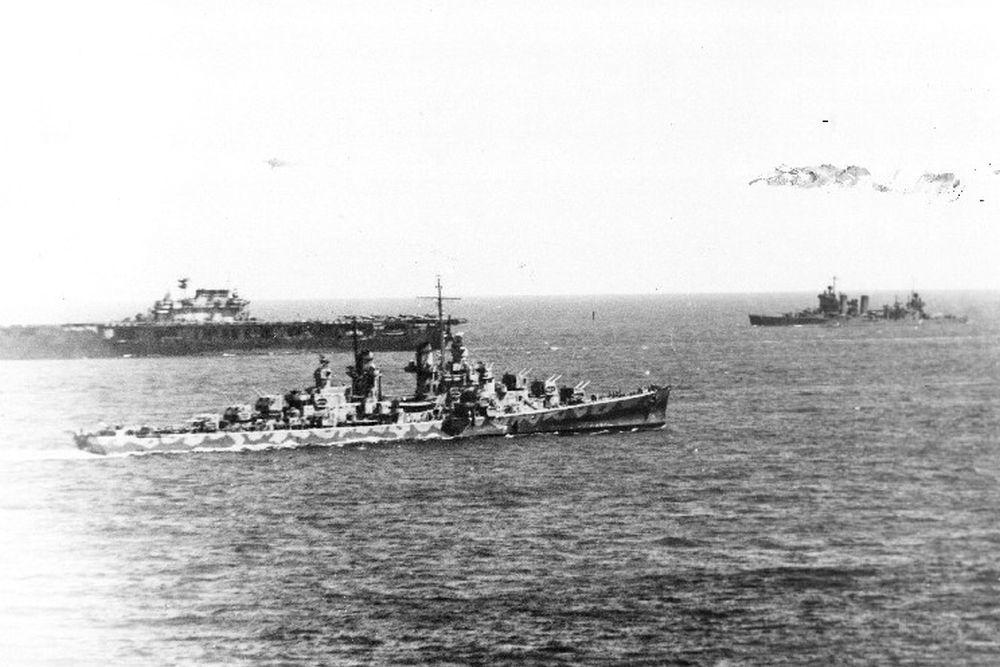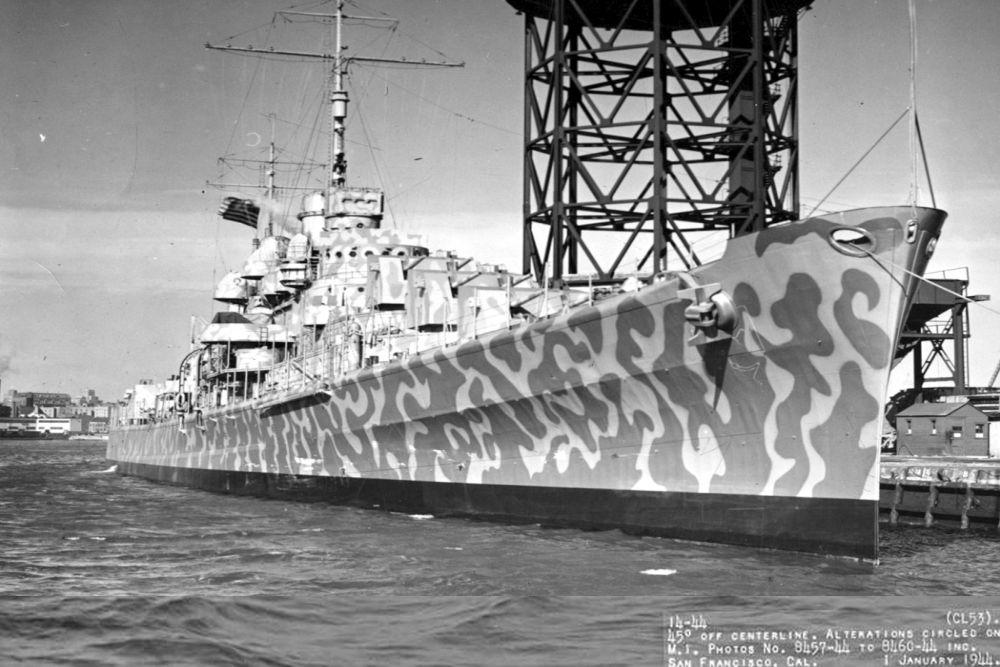Introduction
The Atlanta class of light cruisers consisted of eight ships. Although initially designed to serve as scout scruiser or destroyer flotilla leader, they proved mainly successful as anti-aircraft cruisers. Due to further optimisation for the latter purpose, the last four ships of this class were also referred to as the Oakland class.
Definitielijst
- destroyer
- Very light, fast and agile warship, intended to destroy large enemy ships by surprise attack and eliminating them by using torpedoes.
Ships of this class
| USS Atlanta (CL-51) |
April 22nd, 1940: keel laid
September 6th, 1941: launched December 24th, 1941: commissioned November 13th, 1942: sunk January 13th, 1943: stricken from Naval Register |
| USS Juneau (CL-52) |
May 27th, 1940: keel laid
October 25th,1941: launched February 14th, 1942: commissioned November 13th, 1942: sunk |
| USS San Diego (CL-53) |
March 27th, 1940: keel laid
July 26th, 1941: launched January 10th, 1942: commissioned November 4th, 1946: decommissioned March 1st, 1959: stricken from Naval Register February 3rd, 1960: scrapped |
| USS San Juan (CL-54) |
March 15th, 1940: keel laid
September 6th, 1941: launched February 28th, 1942: commissioned November 9th, 1946: decommissioned May 1st, 1959: stricken from Naval Register October 31st, 1961: scrapped |
| USS Oakland (CL-95) |
July 15th, 1941: keel laid
October 23rd, 1942: launched July 17th, 1943: commissioned July 1st, 1949: decommissioned March 1st, 1959: stricken from Naval Register December 1st, 1959: scrapped |
| USS Reno (CL-96) |
August 1st, 1941: keel laid
December 23rd, 1942: launched December 28th, 1943: commissioned November 4th, 1946: decommissioned March 1st, 1959: stricken from Naval Register March 22nd, 1962: scrapped |
| USS Flint (CL-97) |
October 23rd, 1942: keel laid
January 25th, 1944: launched August 31st, 1944: commissioned May 6th, 1946: decommissioned June 1st, 1965: stricken from Naval Register October 6th, 1966: scrapped |
| USS Tucson (CL-98) |
December 23rd, 1942: keel laid
September 3rd, 1944: launched February 3rd, 1945: commissioned June 11th, 1949: decommissioned June 1st, 1966: stricken from Naval Register February 24th, 1971: scrapped |
History
The Atlanta class consisted of eight light cruisers, of which the first batch of four were designed in 1937 and ordered in 1938 as destroyer flotilla leaders (also called scout cruisers). During the Second World War, these ships proved especially effective as anti-aircraft cruisers. The first batch of four ships were already employed for this particular task. The second batch of four cruisers, starting with the USS Oakland (CL-95), received improved and more extensive armament for the same purpose and were therefore also referred to as the Oakland class. The entire group was sometimes referred to as the Atlanta-Oakland class.[1][2]
The order to build the first two cruisers was given on March 27th, 1934, followed by the order for the third and fourth ships on May 17th, 1938. The last four ships were ordered on July 19th, 1940. The design was originally not intended as an anti-aircraft cruiser but as a destroyer leader.[3][4]
Main armament consisted of 12 x 127mm/38 calibre guns in three double-barrelled turrets mounted forward and the same number mounted aft. The first four ships also had an additional armament of two double-barrelled 127mm/38 calibre guns each mounted on either side of the superstructure. The first four ships also had a secondary armament of 12 x 28mm/75 calibre anti-aircraft guns across three quadruple mountings. This anti-aircraft defence was replaced by 40mm Bofors artillery in the course of 1942. Around the same time, eight rapid-fire anti-aircraft guns were added to the armament, which number was further increased from 1943 onwards. The second group of ships only received the main armament of six double-barrelled turrets, three forward and three aft. The side turrets were replaced with anti-aircraft guns. The same was done with the first group of light cruisers, from 1943 onwards. As the Second World War progressed, the ships could differ from each other in the amount of anti-aircraft armament that was present at any given time.[5]

USS Atlanta (CL-51) with the USS Hornet (CV-8) and USS Vincennes (CA-44) at the Battle of Midway. Source: U.S. Navy photo
A radar installation was not included in the construction, but during 1942 all ships were fitted with an FD (Mk 4) radar. On ships still in service, this was replaced in the course of 1943 by an FD Mk 12/Mk 22 combination radar. Although the ships were designed as destroyer flotilla leaders, they lacked no anti-submarine equipment. Together with the radar upgrade in 1942, the ships received sonar, six depth charge launchers and two depth charge racks on the stern. This was later largely removed to allow for more anti-aircraft defence capacity.
The USS Atlanta (CL-51) and USS Juneau (CL-52) were lost on November 13th, 1942, during the Battle of Guadalcanal. This mainly showed that although the ships were capable air defence cruisers, they were less suitable for operating during naval battles. The various deficiencies found were corrected during the war in the follow-up design, the Juneau class. The six remaining ships survived the Second World War and were classified as anti-aircraft cruisers in 1949 with the designation CLAA. From 1959 onwards, the ships were gradually phased out and the last one was scrapped in 1971.[6]
Definitielijst
- cruiser
- A fast warship with 8,000 – 15,000 ton displacement, capable to perform multiple tasks such as reconnaissance, anti-aircraft defence and convoy protection.
- destroyer
- Very light, fast and agile warship, intended to destroy large enemy ships by surprise attack and eliminating them by using torpedoes.
- radar
- English abbreviation meaning: Radio Detection And Ranging. System to detect the presence, distance, speed and direction of an object, such as ships and airplanes, using electromagnetic waves.
Technical data
| Class: | Atlanta class |
| Number of ships: |
8 |
| Country: |
United States of America |
| Type: |
Light cruiser / anti-aircraft cruiser |
| Displacement: |
6,000 lt (standard) 7,400 lt (fully loaded) |
| Length: |
165 meter |
| Beam: |
16.10 meter |
| Draft: |
6.25 meter |
| Installed power: |
4 x 665 psi boilers
2 geared turbines Power: 75,000 shp (56 MW) |
| Speed: |
32.5 knots (62 km/h) |
| Maximum range: |
15,700 km (at 15 knots) |
| Armament (standard): |
Standard:
8x2 127 mm/38 calibre guns 3x4 or 4x4 28 mm/75 calibre guns 6x 20 mm/70 calibre anti-aircraft guns 2x4 533 mm torpedo tubes Oakland sub-class (CL 95-99): 6x2 127 mm/38 calibre guns 8x2 40 mm/56 calibre anti-aircraft guns 16x 20 mm/70 calibre anti-aircraft guns 2x4 533 mm torpedo tubes |
| Complement: |
673 (813: Oakland sub-class) |
Notes
- Silverstone, 2012, pag. 29
- Mooney, 1991, pag. 450
- Mooney, 1964, pag. 215
- Stille, 2016
- Fitzsimons, 1971, pag. 188
- Warship International, 1982, pag 189
Definitielijst
- cruiser
- A fast warship with 8,000 – 15,000 ton displacement, capable to perform multiple tasks such as reconnaissance, anti-aircraft defence and convoy protection.
- torpedo
- A weapon of war. A cigar shaped body fitted with explosives and a propulsion and control mechanism. Intended to target after launch a nearby enemy ship and disable it by underwater explosion.
Information
- Article by:
- Wilco Vermeer
- Article by:
- Simon van der Meulen
- Published on:
- 12-12-2024
- Feedback?
- Send it!
Related books
Sources
- Warship International, Volume 19, International Naval Research Organization, 1982.
- BAUER, K.J. & ROBERTS, S.S., Register of Ships of the U.S. Navy, 1775-1990: Major Combatants, Greenwood Publishing Group, 1991.
- FITZSIMONS, B., The Illustrated Encyclopedia of 20th Century weapons and Warfare, Volume 2, Columbia House, 1971.
- FRIEDMAN, N., U.S. Cruisers: An Illustrated Design History, Naval Institute Press, 1984.
- MOONEY, J.L. EA e.a., Dictionary of American Naval Fighting Ships, Volume 1 Part A, U.S. Government Printing Office, 1991.
- MORRIS, M.J. & KEARNS, P.M., Historical Dictionary of the United States Navy, Scarecrow Press, 2011.
- SCOTT, W.E., The World at War, 1939-1945, Xlibris, 2002.
- SILVERSTONE, P., The Navy of World War II, 1922-1947, Routledge, 2012.
- STILLE, M., US Navy Light Cruisers 1941–45, Bloomsbury Publishing, 2016.







